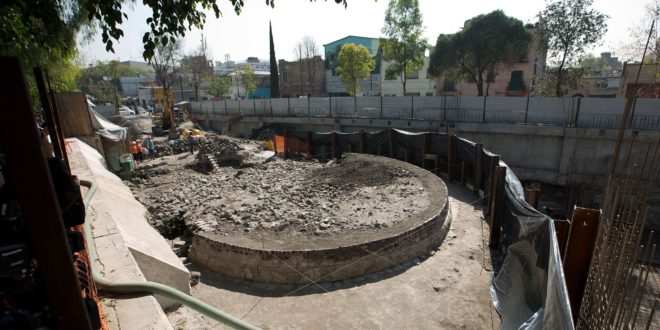Working at the site of a demolished supermarket in Mexico City, archaeologists dug 10 feet down to find a temple built more than 650 years ago, researchers announced on Wednesday December 1.
The circular platform, about 36 feet in diameter and four feet tall, now sits in the shadow of a shopping mall under construction. The site is believed to have been built to worship the god of wind, Ehecatl-Quetzalcoatl, and the plans are to preserve it and make it visible to the public with a large viewing window.
What archaeologists initially found below the old supermarket – shards of pottery and human remains – was expected, said Pedro Francisco Sanchez Nava, national archaeology coordinator for Mexico’s National Anthropology and History Institute.

A view of a temple found in Mexico City, Wednesday Nov. 30, 2016. The circular platform, about 36 feet in diameter and four feet tall, now sits in the shadow of a shopping mall under construction. But the site believed to be built to worship the god of wind, Ehecatl-Quetzalcoatl, was deemed valuable enough to preserve. (AP Photo/Eduardo Verdugo)
But deeper down they were surprised to find the temple, which offers another example of how the Mexica-Tlatelolca people worshipped one of their principal deities, Sanchez said. Offerings found included an infant with no signs of trauma, bird bones, obsidian, maguey cactus spines and ceramic figurines of monkeys and duck bills.
The majority of the temple’s original white stucco remains intact. Archaeologist Salvador Guilliem said similar structures, round on three sides and with a rectangular platform on the fourth, have been found before, including in the same area.
The temple lies within the perimeter of a large ceremonial site in the capital’s Tlatelolco neighborhood, though much of that perimeter is invisible, covered by an urban landscape.
Eduardo Matos Moctezuma, researcher emeritus, said modern day Mexico City covers several different pre-Hispanic cities, including Tlatelolco and its rival Tenochtitlan.
Tenochtitlan was a center of political power while Tlatelolco dedicated itself to commerce, with an important market that was noted even by Spanish conquistador Hernan Cortes. Eventually Tenochtitlan took control of Tlatelolco.
When the Spanish and their indigenous allies began conquering Tenochtitlan, residents of that city withdrew to Tlatelolco to continue the fight, and Tlatelolco became the last site of resistance against the Spanish in the area.
The site of the recently uncovered temple is just yards away from where Mexican soldiers massacred protesting students in 1968.
Source: http://www.vallartadaily.com/

